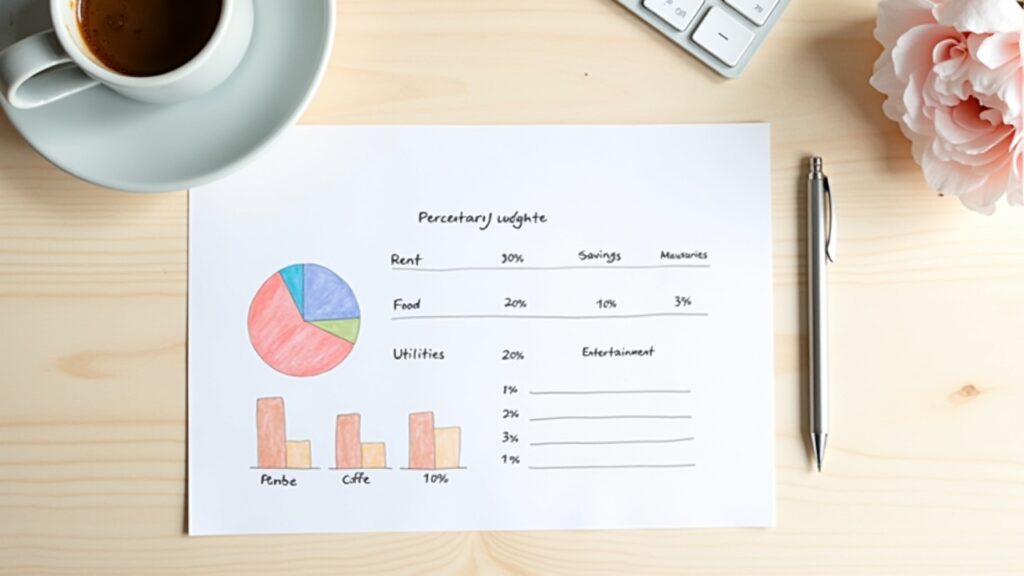Advertisements
Did you know that 65% of Americans don’t know how much they spent last month? I used to be one of them! My bank account was like a mysterious black hole where money just… disappeared. Then I discovered percentage based budgeting, and honestly, it changed everything.
Look, I get it. Budgeting sounds about as fun as watching paint dry. But here’s the thing – this method is different because it’s ridiculously simple and actually works with how our brains think about money.
What Exactly Is Percentage Based Budgeting?

Okay, so percentage based budgeting is basically dividing your income into set percentages for different spending categories. Instead of tracking every penny (who has time for that?), you just allocate chunks of your paycheck. It’s like cutting a pie – each slice has its purpose.
When I first heard about it, I thought “Great, more math.” But it’s actually way easier than traditional budgeting methods. You’re just working with simple percentages, not complex spreadsheets that make your eyes glaze over.
The beauty is in its flexibility. Unlike the rigid 50/30/20 rule, you can adjust the percentages to fit your actual life. Because let’s be real – we all have different priorities and situations.
The Classic Percentage Breakdown (That I Totally Tweaked)
Most financial experts recommend something like this:
- 50% for needs (rent, utilities, groceries)
- 30% for wants (fun stuff, eating out)
- 20% for savings and debt payoff
But here’s where I messed up initially. I tried to follow this exactly and it was a disaster! My rent alone was eating up 35% of my income. So I had to get creative and adjust.
After some trial and error (and a few months of ramen noodles), here’s what actually worked for me:
- 60% for needs (because city living ain’t cheap)
- 20% for wants (had to cut back on the fun budget)
- 15% for savings
- 5% for that random stuff that always pops up
Setting Up Your Own Percentage System
First things first – you gotta know your take-home pay. Not your salary, but what actually hits your bank account after taxes. This was embarrassing for me because I’d been working for three years and never really paid attention to this number!
Next, track your spending for just one month. I know, I know – tracking is annoying. But you can use apps like Mint or even just your bank’s app to see where your money’s going. The results might shock you (mine sure did).
Then comes the fun part – playing with percentages. Start with the standard 50/30/20 and adjust based on your reality. Live in an expensive city? Maybe bump up that needs category. Got debt to tackle? Increase your savings percentage.
My Biggest Percentage Budgeting Mistakes
Oh boy, where do I start? My first month, I forgot to include my gym membership in any category. It just… wasn’t there. The payment bounced and I got hit with fees.
Another time, I was so rigid with my percentages that I wouldn’t buy toilet paper because I’d maxed out my “needs” category. Yeah, that was not my brightest moment. Sometimes you gotta be flexible!
The worst mistake though? Not having a buffer category. Life happens – cars break down, friends have birthdays, your favorite band comes to town. Without some wiggle room, the whole system falls apart.
Making It Work in Real Life
Here’s what nobody tells you about percentage budgeting – it takes a few months to get it right. The first month is gonna be wonky. You’ll probably mess up the percentages or forget entire categories (hello, annual subscriptions!).
I started using automatic transfers to make it foolproof. As soon as my paycheck hit, boom – money moved to different accounts based on my percentages. My savings account grew without me even thinking about it!
Pro tip: Use different bank accounts or savings buckets for each percentage category. It’s way easier to see if you’re overspending when the money is physically separated.
The Unexpected Benefits
Something weird happened after a few months of percentage budgeting. I stopped stressing about money constantly. Since everything had its place, I could actually enjoy spending my “fun money” without guilt!
Decision fatigue disappeared too. Should I buy this coffee? Well, do I have money in my wants category? Yes? Then go for it! No complex calculations needed.
The best part? I actually started saving money. Like, real money in a real savings account. After years of living paycheck to paycheck, seeing that number grow was incredibly motivating.
Your Turn to Take Control

Look, percentage based budgeting isn’t magic. It won’t suddenly make you rich or solve all your money problems. But it will give you a simple framework that actually makes sense.
Start small – maybe just try it for one month. Adjust the percentages as you go. Remember, the best budget is the one you’ll actually stick to, not some perfect system that looks good on paper but fails in real life.
And hey, if you’re looking for more practical money tips that actually work in the real world, check out other posts on Cashflow Zen. We’re all about finding that sweet spot between financial responsibility and actually enjoying life. Because what’s the point of having money if you can’t have a little fun with it?




[…] to tackle more money-saving strategies? Check out other budget-friendly tips and financial wellness ideas at Cashflow Zen. Your wallet (and your family) will thank […]